Hydrotherapy offers a low-impact, effective way to aid recovery after knee replacement surgery․ Water-based exercises reduce inflammation, improve mobility, and strengthen muscles without excessive strain on the joint․
What is Hydrotherapy?
Hydrotherapy, or water therapy, is a form of rehabilitation that uses water to promote healing and improve physical function․ It leverages the buoyancy, resistance, and soothing properties of water to reduce pain, inflammation, and stiffness․ Commonly used after knee replacement surgery, hydrotherapy involves gentle exercises such as knee bends, straightening, and range-of-motion activities․ These exercises are typically performed in a swimming pool or hydrotherapy pool, where the water’s support reduces strain on the knee joint․ Hydrotherapy is often prescribed by physiotherapists to enhance recovery, strengthen muscles, and improve mobility in a controlled, low-impact environment․ It is also known for its calming effects, making it an ideal complement to traditional rehabilitation methods․
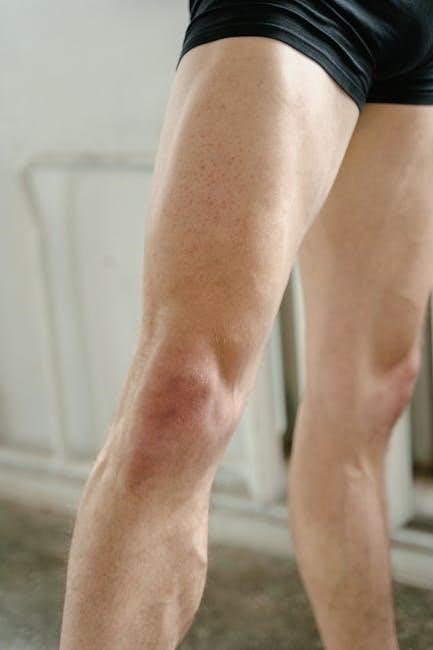
Benefits of Hydrotherapy in Knee Rehabilitation
Hydrotherapy is a highly effective, low-impact method for knee rehabilitation, offering numerous benefits․ It reduces pain and inflammation, enhances joint mobility, and strengthens surrounding muscles without putting excessive strain on the knee․ The buoyancy of water minimizes stress on the joint, allowing for gentle yet effective exercises․ Hydrotherapy also improves circulation, promoting healing and reducing swelling․ Additionally, the soothing properties of water provide a calming environment, making it easier for patients to perform exercises comfortably․ Regular hydrotherapy sessions can accelerate recovery, improve functional abilities, and enhance overall quality of life after knee replacement surgery․ It is often recommended as a complement to traditional rehabilitation programs․
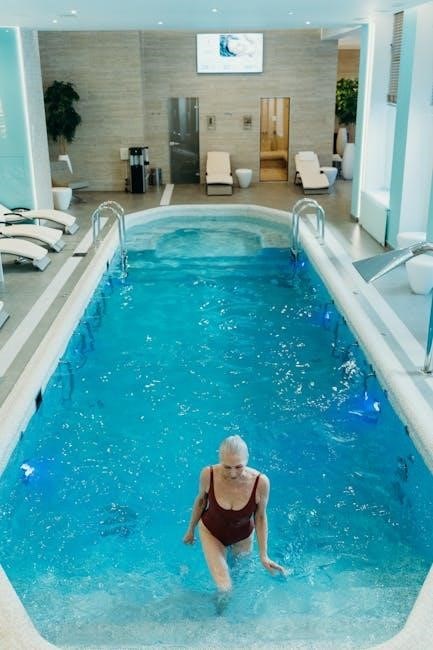
Types of Hydrotherapy Exercises for Knee Replacement
Hydrotherapy exercises for knee replacement include knee bends, straightening, range of motion activities, strengthening exercises, and aerobic exercises․ These improve mobility, strength, and joint function․
- Knee Bends and Straightening Exercises
- Range of Motion Activities
- Strengthening Exercises in Water
- Aerobic and Mobility Exercises
Knee Bends and Straightening Exercises
Knee bends and straightening exercises are fundamental in hydrotherapy for knee replacement․ These exercises help improve flexibility and strength by gently moving the knee through its range of motion․ Patients are guided to bend their knees slowly while standing or sitting in the water, then straighten them again․ This motion reduces stiffness and enhances joint mobility․ The water’s buoyancy minimizes strain, making these exercises ideal for early recovery stages․ Regular practice promotes healing and prepares the knee for more advanced movements․ These exercises are often performed in shallow water, allowing for controlled and comfortable progression;
- Improves knee flexibility and range of motion․
- Strengthens surrounding muscles without excessive strain․
- Enhances joint mobility and reduces stiffness․
Range of Motion Activities
Range of motion activities in hydrotherapy focus on improving knee mobility through gentle, controlled movements․ These exercises help restore flexibility and reduce stiffness after knee replacement․ Patients perform movements like knee lifts, leg swings, and ankle pumps while in the water․ The buoyancy of water supports the leg, minimizing strain and allowing for smooth, pain-free motion․ These activities are particularly beneficial in the early stages of recovery, as they promote healing and prepare the knee for more strenuous exercises․ Regular practice enhances joint mobility and reduces the risk of long-term stiffness, ensuring a smoother recovery process․
- Improves knee flexibility and mobility․
- Reduces stiffness and promotes healing․
- Prepares the knee for advanced exercises․
Strengthening Exercises in Water
Strengthening exercises in water are essential for rebuilding muscle around the knee after replacement surgery․ These exercises utilize water resistance to target key muscle groups without excessive joint strain․ Common exercises include leg presses, water-based squats, and resistance walks․ The viscosity of water provides natural resistance, helping to strengthen the quadriceps, hamstrings, and calf muscles․ These exercises improve joint stability and overall knee function, reducing the risk of future injuries․ They are typically introduced after initial range of motion activities, as the knee becomes more mobile and stronger․ A physiotherapist often tailors these exercises to individual needs, ensuring safe and effective progression․
- Targets quadriceps, hamstrings, and calf muscles․
- Uses water resistance for natural strength-building․
- Improves joint stability and function․
Aerobic and Mobility Exercises
Aerobic and mobility exercises in water are crucial for improving circulation, boosting mood, and enhancing overall knee function after replacement surgery․ These exercises, such as water walking, swimming laps, or gentle stretching, help increase cardiovascular health without stressing the knee joint․ Mobility exercises, like leg swings and arm movements, improve flexibility and coordination․ They are often performed in conjunction with strengthening exercises to promote a balanced recovery․ A physiotherapist may incorporate these activities into hydrotherapy sessions, gradually increasing intensity as the patient progresses․ These exercises not only aid physical recovery but also contribute to mental well-being by reducing stress and promoting relaxation․
- Improves circulation and cardiovascular health․
- Enhances flexibility and coordination․
- Boosts mood and mental well-being․
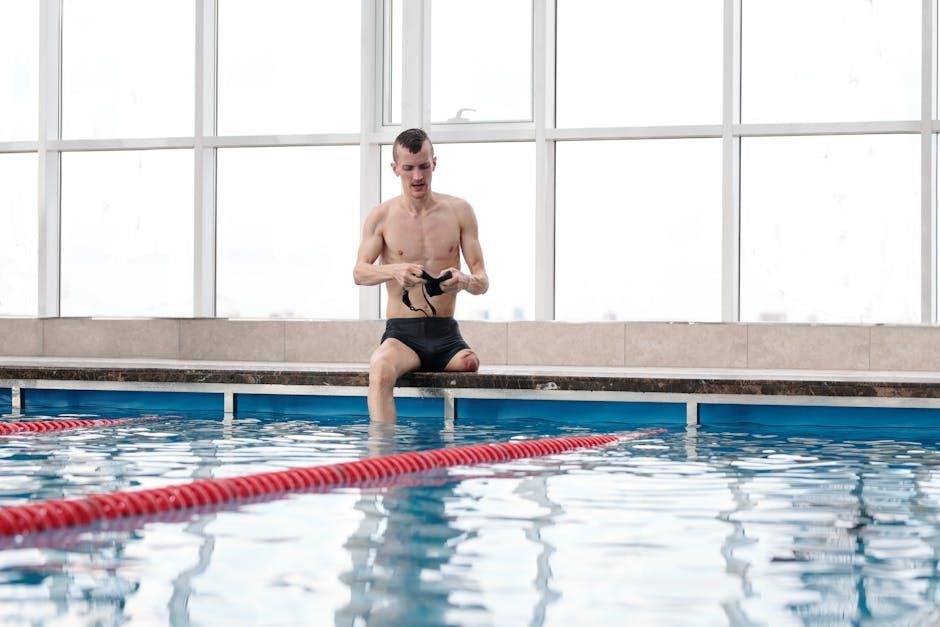
When to Start Hydrotherapy After Knee Replacement
Hydrotherapy typically begins 6-8 weeks post-surgery, once the wound has healed․ Gentle exercises are introduced to avoid overstraining the knee, with sessions progressing gradually under physiotherapist guidance․
Timing and Frequency of Sessions
Hydrotherapy sessions for knee replacement typically begin 6-8 weeks post-surgery, with 2-3 sessions per week․ Initial exercises focus on gentle movements to avoid overstraining the knee․ Patients often perform exercises 6-8 times daily, followed by ice and leg elevation to reduce swelling․ As recovery progresses, sessions may transition to a swimming pool for continued rehabilitation․ Consistency is key, with each session lasting 20-30 minutes․ A physiotherapist tailors the frequency and intensity based on individual progress․ Proper hydration is essential, as pool heat can cause dehydration․ Monitoring pain levels ensures exercises remain safe and effective, promoting gradual improvement in mobility and strength․
Progression of Exercises Over Time

Hydrotherapy exercises for knee replacement progress gradually, starting with gentle movements to restore range of motion and basic strength․ Initially, focus is on knee bends, straightening, and range of motion activities․ As recovery advances, exercises intensify to include strengthening and aerobic activities, such as walking or swimming in the pool․ Over time, exercises are modified to increase resistance and complexity, promoting greater mobility and muscle endurance․ Physiotherapists adjust the program based on individual progress, ensuring exercises remain challenging yet safe․ The goal is to transition from clinical hydrotherapy to independent exercises at home, using equipment or a swimming pool for continued rehabilitation․
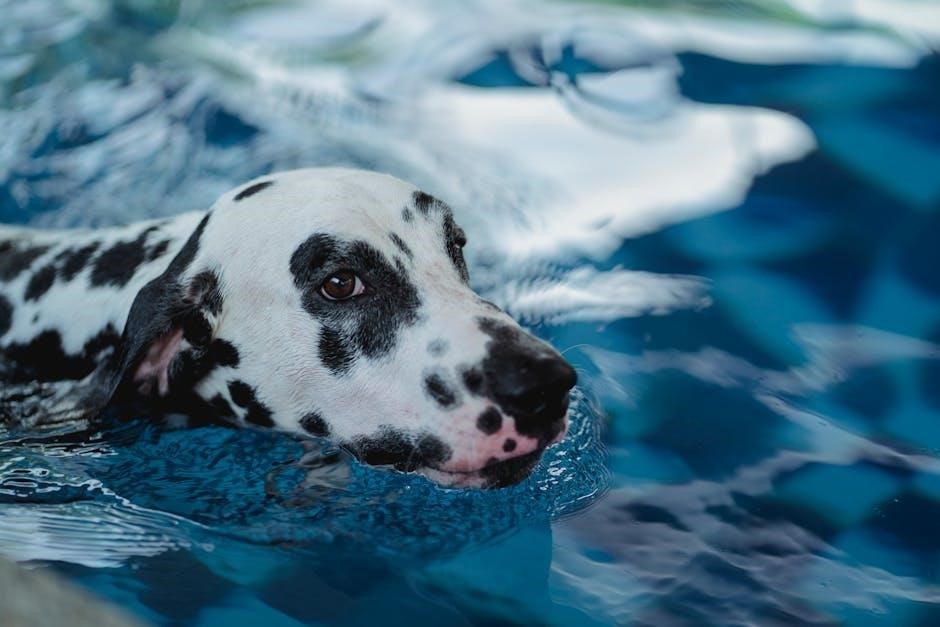
Creating a Hydrotherapy Exercise Routine
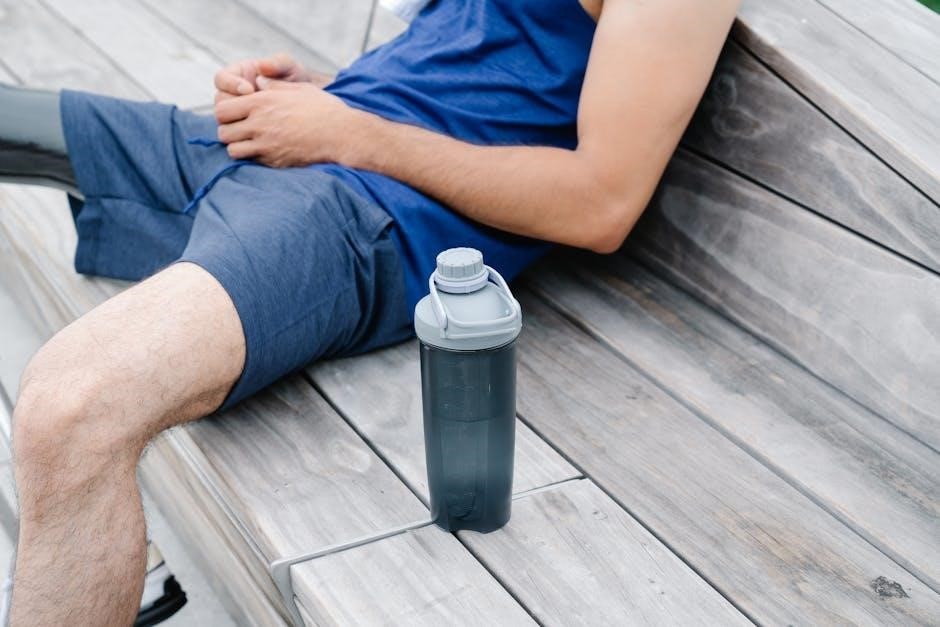
A well-structured hydrotherapy plan, tailored to individual needs, ensures gradual progression and safety․ Exercises are prescribed by physiotherapists, focusing on specific goals like strength and mobility․ Sessions can transition from clinical to home settings, using pools or equipment, while emphasizing hydration and proper technique to optimize recovery․
Frequency and Duration of Sessions
Hydrotherapy sessions for knee replacement typically begin with 2-3 times per week, lasting 20-30 minutes; As recovery progresses, frequency and duration can increase․ Initial sessions focus on gentle exercises to improve mobility and strength, while advanced sessions incorporate more dynamic movements․ The physiotherapist tailors the plan to individual progress, ensuring exercises remain challenging yet safe․ Consistency is key, with gradual increases in intensity and time․ Proper hydration is essential, as pool sessions can cause dehydration․ Over time, patients can transition to performing exercises independently in a swimming pool or at home, maintaining the routine for optimal recovery․
Individualizing the Exercise Plan
Each patient’s hydrotherapy plan is tailored to their specific needs and recovery stage․ A physiotherapist assesses the patient’s mobility, strength, and pain levels to create a personalized routine․ Exercises are modified based on progress, ensuring they remain effective and safe․ For example, knee bends may be introduced gradually, starting with small ranges of motion and increasing as strength improves․ The plan also considers any physical limitations or discomfort, adjusting intensity and complexity accordingly․ This individualized approach ensures optimal recovery, with exercises evolving as the patient progresses․ Regular reassessment by the physiotherapist guarantees the plan remains aligned with the patient’s goals and abilities․
Role of Physiotherapist Guidance
A physiotherapist plays a crucial role in hydrotherapy for knee replacement, ensuring exercises are performed safely and effectively․ They assess the patient’s condition, prescribe tailored exercises, and monitor progress․ Physiotherapists provide feedback on technique, helping patients avoid improper movements that could hinder recovery․ They also adjust the exercise plan as needed, based on the patient’s response and recovery stage․ Their expertise ensures that hydrotherapy sessions are both therapeutic and progressive, maximizing the benefits of water-based rehabilitation․ Regular guidance helps patients stay motivated and informed, fostering a smooth and effective recovery journey after knee replacement surgery․
Progression of Hydrotherapy Exercises
Hydrotherapy exercises progress from basic movements to more complex activities, gradually increasing intensity and complexity as recovery advances, ensuring a structured approach to rehabilitation․
Modifying Exercises for Different Stages of Recovery
Hydrotherapy exercises are tailored to individual recovery stages post-knee replacement․ Early stages focus on gentle movements to reduce pain and improve mobility, while later stages incorporate strengthening and flexibility exercises․ Physiotherapists adjust exercises based on progress, ensuring they align with the patient’s healing timeline․ Modifications may include increasing resistance, introducing advanced movements, or focusing on specific muscle groups․ The goal is to gradually build strength and confidence without overloading the joint․ Proper guidance ensures exercises remain safe and effective, promoting a smooth transition from recovery to full mobility․
Increasing Intensity and Complexity
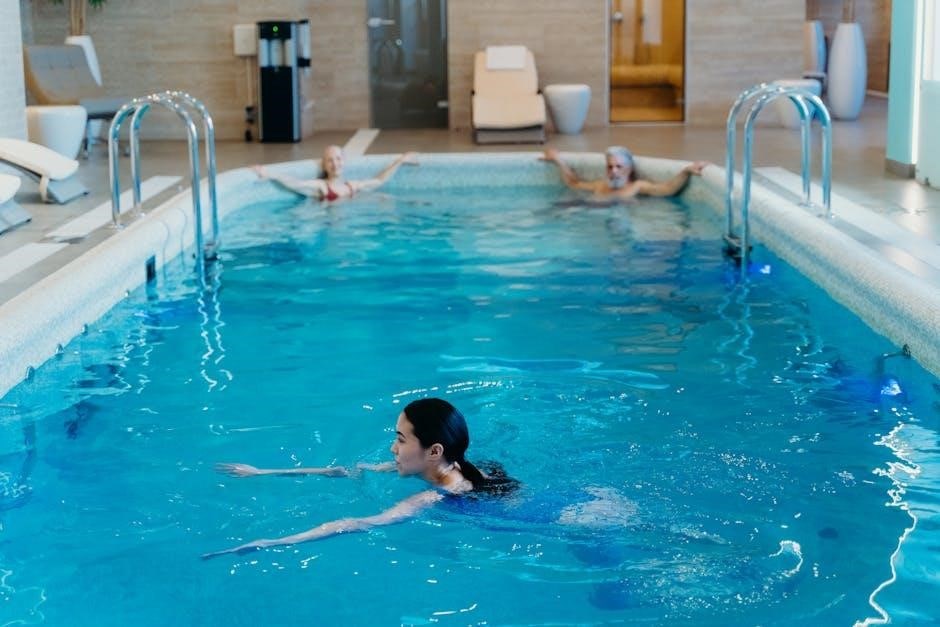
As recovery progresses, hydrotherapy exercises are gradually intensified to challenge the knee joint and surrounding muscles․ Initially, gentle movements like knee bends and straightening are performed․ Over time, exercises become more dynamic, incorporating resistance bands or water currents to strengthen muscles․ Deep water walking, high knees, and lateral movements are introduced to enhance mobility and endurance․ The complexity increases with balance exercises, single-leg stands, and functional activities mimicking daily movements․ Physiotherapists tailor these advancements to individual progress, ensuring exercises remain challenging yet safe․ This structured progression helps restore full knee function, preparing patients for everyday activities and more strenuous tasks․
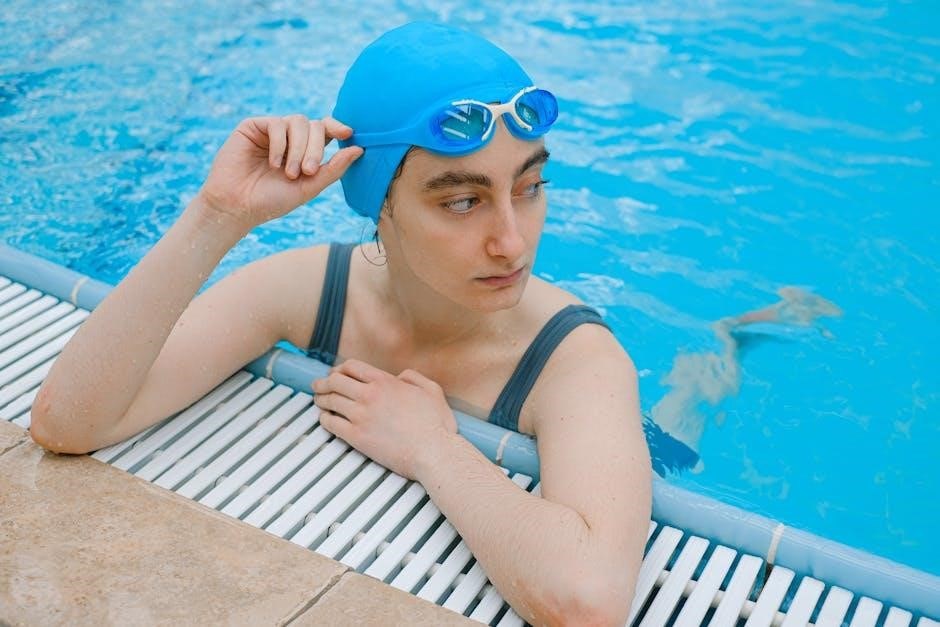
Home vs․ Clinical Hydrotherapy
Clinical hydrotherapy offers professional supervision and advanced equipment, while home therapy provides convenience and accessibility for continued recovery with basic exercises and equipment․
Exercising in a Swimming Pool
Exercising in a swimming pool is a popular form of hydrotherapy for knee replacement recovery․ The buoyancy of water reduces joint stress, allowing for gentle knee bends, straightening, and range of motion activities․ These exercises, often performed 6-8 times daily, help improve mobility and strength without strain․ Pool exercises are typically guided by a physiotherapist to ensure proper technique and progression․ Once comfortable, patients can transition to performing these exercises independently in a local swimming pool, making it a convenient option for continued rehabilitation․ The water’s therapeutic properties enhance recovery, reducing pain and inflammation while promoting overall joint function․
Using Hydrotherapy Equipment at Home
Using hydrotherapy equipment at home can be an effective way to continue knee replacement rehabilitation․ Tools like resistance jets, underwater treadmills, or even simple pool noodles can enhance exercises․ These devices help strengthen muscles and improve joint mobility without excessive strain․ Home equipment allows for convenient and consistent practice of exercises such as knee lifts, leg stretches, and gentle resistance movements․ Always consult a physiotherapist to tailor exercises to your recovery stage․ The AHS-9140-ENG PDF guide provides detailed instructions for home-based hydrotherapy, ensuring safety and effectiveness․ Proper use of equipment and adherence to guidelines are crucial for optimal recovery outcomes․
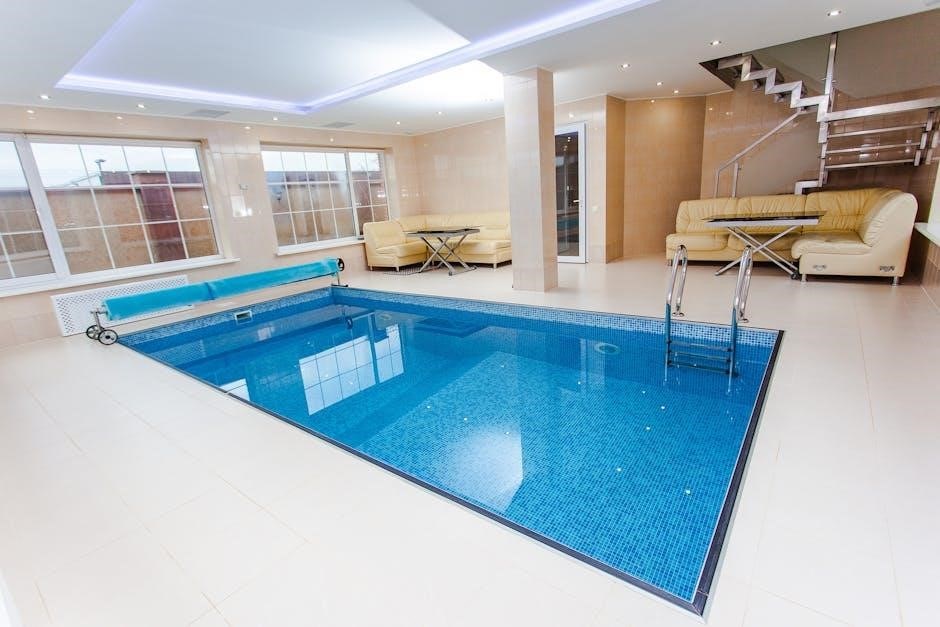
Safety Considerations for Hydrotherapy
Monitor pain and discomfort during sessions; Stay hydrated to avoid dehydration from pool heat․ Ensure pool safety by using supportive equipment and avoiding slippery surfaces․
Monitoring Pain and Discomfort
Monitoring pain and discomfort is crucial during hydrotherapy sessions․ Patients should stop exercises if pain exceeds a moderate level (5/10 on a pain scale)․ Communicate with your physiotherapist to adjust exercises accordingly․ Proper pain management ensures safe progression and avoids overstrain․ Listen to your body and report any unusual discomfort promptly․ This approach helps maintain a balance between effective rehabilitation and joint protection, ensuring a smooth recovery process after knee replacement surgery․
Hydration and Pool Safety
Hydration is essential during hydrotherapy sessions, as the heat from the pool can cause dehydration․ Patients should drink plenty of fluids before, during, and after sessions․ Pool safety is also critical; ensure the area is clear of hazards and non-slip surfaces are in place․ Always supervise exercises, especially for those with balance issues․ Use assistive devices like pool noodles or bars if needed․ Avoid overheating by taking regular breaks․ Proper hydration and safety measures ensure a safe and effective hydrotherapy experience, promoting recovery without complications․
Contraindications for Hydrotherapy
While hydrotherapy is beneficial for many, certain conditions may make it unsuitable․ Open wounds, active infections, or severe cardiovascular issues can contraindicate its use․ Patients with uncontrolled hypertension, severe arthritis, or recent fractures should avoid hydrotherapy․ Additionally, individuals with neurological conditions affecting balance or sensation may require extra precautions․ It’s crucial to consult a healthcare provider before starting hydrotherapy, especially for those with pacemakers or other implanted devices․ Proper screening ensures safe participation and avoids potential complications, making hydrotherapy a safe and effective option for most knee replacement patients when guidelines are followed․
Hydrotherapy Exercises for Knee Replacement PDF Resources
The AHS-9140-ENG PDF document provides a comprehensive guide to hydrotherapy exercises for knee replacement, offering detailed routines and tips for post-surgery rehabilitation․
Overview of the AHS-9140-ENG PDF Document
The AHS-9140-ENG PDF document is a comprehensive guide to hydrotherapy exercises for knee replacement recovery․ It outlines detailed routines, tips, and illustrations to help patients improve mobility and strength․ The document covers exercises ranging from basic to advanced, focusing on knee bends, straightening, and range of motion activities․ It also provides structured programs for specific recovery stages, ensuring a gradual and safe progression․ Designed for post-surgery rehabilitation, the guide emphasizes the importance of physiotherapist guidance and individualized plans․ Patients can use this resource to transition from clinical hydrotherapy to home-based exercises, making it a valuable tool for long-term recovery and independence․
Downloading and Using the Guide
The AHS-9140-ENG PDF guide is easily accessible online, offering a free resource for post-knee replacement rehabilitation․ Patients can download it from trusted healthcare websites or hospital portals․ The guide provides step-by-step instructions for hydrotherapy exercises, including knee bends, straightening, and range of motion activities․ It also includes illustrations to ensure proper technique․ Users are advised to consult their physiotherapist before starting any routine․ The guide is designed to be user-friendly, allowing patients to track their progress and adjust exercises as needed․ Regular use of the guide can enhance recovery outcomes, making it an essential tool for both clinical and home-based hydrotherapy sessions․
Additional PDF Resources for Knee Rehabilitation
Beyond the AHS-9140-ENG guide, several other PDF resources are available to support knee rehabilitation through hydrotherapy․ These include comprehensive exercise manuals and recovery plans tailored for post-surgery patients․ Resources like “Water Exercise” by Martha White and “Heal Your Knees” by Robert L․ Klapper offer detailed routines and tips for improving mobility and strength․ Many hospital websites and orthopedic centers provide free downloadable PDFs with hydrotherapy exercises specifically designed for knee replacement recovery․ These guides often include illustrations and progress tracking tools․ Patients are encouraged to explore these resources to supplement their rehabilitation journey, ensuring a well-rounded and effective recovery process under professional guidance․
Hydrotherapy is a proven, effective method for knee replacement recovery, offering pain reduction, improved mobility, and muscle strength․ Utilize the AHS-9140-ENG PDF and other resources for guided exercises and tips to enhance your rehabilitation journey and achieve a faster, smoother recovery․
Final Thoughts on Hydrotherapy for Knee Replacement
Hydrotherapy is a highly effective and gentle approach for knee replacement recovery, offering significant benefits such as reduced pain, improved mobility, and strengthened muscles․ The AHS-9140-ENG PDF guide provides comprehensive exercises tailored for post-surgery rehabilitation, ensuring a structured and safe approach․ By incorporating hydrotherapy into your routine, you can enhance your recovery process, regain strength, and restore joint function․ Consistency and adherence to the prescribed exercises, along with professional guidance, are key to achieving optimal results․ Embrace hydrotherapy as a vital component of your rehabilitation journey to accelerate healing and return to an active lifestyle with confidence and ease․
Encouragement to Continue Rehabilitation
Remember, every small step in your hydrotherapy journey contributes to a stronger, more mobile you․ Stay committed to your exercises, as consistency is key to achieving lasting results․ Celebrate progress, no matter how small, and remain patient with your body as it heals․ The guidance of your physiotherapist, combined with the structured exercises in the AHS-9140-ENG PDF, will support your recovery․ Keep in mind, hydrotherapy is a proven method to enhance mobility and reduce pain, helping you regain independence and confidence․ Your dedication today will lead to a better quality of life tomorrow—stay motivated and keep moving forward!
